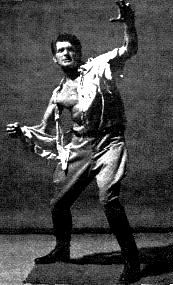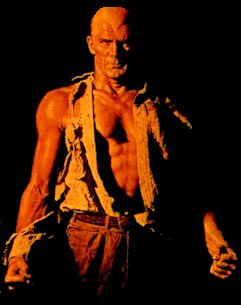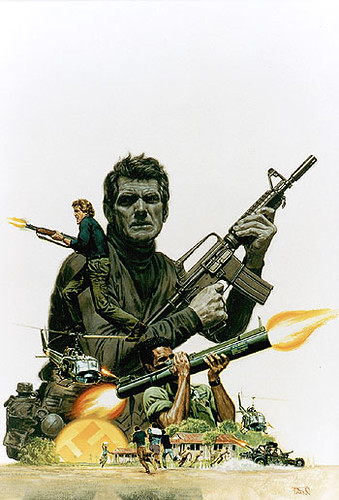 Sometime in the late 80s, visiting a buddy in the Lower East Side, I heard about the sightings of Doc Savage in Alphabet City.
Sometime in the late 80s, visiting a buddy in the Lower East Side, I heard about the sightings of Doc Savage in Alphabet City.Not some Bohemian adventure that Lester Dent had failed to transcribe. Not some Philip Jose Farmer pulp hero retired to Sin City satirical homage.
No, this was the real thing, as in, "Dude, I was walking down to the coffee shop the other day and I saw *Doc Savage* headed for the train."
I was jealous. Later, I heard of other sightings, many of them second hand.
In a coffee shop last year I came across a Portland zine, Book Happy, which featured an article by Ken DeVries about "That Guy!" -- the craggy, frequently half-naked man whose image adorns a large number of genre paperbacks of the late 60s and early 70s.
I recognized that guy. He was Doc Savage. The Doc Savage of the Bantam paperbacks, the embodiment of the spirit of Men's Adventure circa 1973. The guy my buddies said they had seen walking the streets of Ed Koch's New York, albeit with the bronze bleached out from years of high mileage fighting the evildoers.

He was also the face of a hundred other pulp heroes and pop archetypes of masculinity. Nick Carter. The Avenger. The Spy With the Blue Kazoo. The President's Agent. The Professionals. The man getting the benefits of The Harrad Experiment. Desmond Morris' The Naked Ape. Dig around any section of the nearest run-down paperback exchange and you'll find him.
At my neighborhood comic shop last weekend I came across the new coffee table tome about illustrator James Bama, official psychic sculptor of my personal juvenile Zeitgeist.
 A section of the book talks about the man who served in all these roles. Turns out, as I had earlier learned, it *was* all the same guy. Steve Holland, an actor (1950s Flash Gordon TV series, among other things) who became the most popular model for the pulp illustrators. He had the look. Not the steroid-fueled suburban gym look of the Boris Vallejo guys, not the fluid expressionist barbarian energy of the Frazetta guys, but the chiseled and grizzled creases of the dark side of the greatest generation, the guys who came into their looks by fighting actual wars and living off the grit of the mid-20th century. All Spillane, no Schwarzenegger.
A section of the book talks about the man who served in all these roles. Turns out, as I had earlier learned, it *was* all the same guy. Steve Holland, an actor (1950s Flash Gordon TV series, among other things) who became the most popular model for the pulp illustrators. He had the look. Not the steroid-fueled suburban gym look of the Boris Vallejo guys, not the fluid expressionist barbarian energy of the Frazetta guys, but the chiseled and grizzled creases of the dark side of the greatest generation, the guys who came into their looks by fighting actual wars and living off the grit of the mid-20th century. All Spillane, no Schwarzenegger. Turns out, according to Bama, the only thing Holland did to maintain his appearance was play a little urban handball against a concrete wall.
He was the archetypal representation of the uber-character of the entire meta-genre. Leathered face and gaunt musculature revealing everything you needed to know about the character. A face that had never looked at itself in a mirror, unless you count that blood-clouded puddle in the mud. Skin that had never been exposed to cathode rays or skin creams. A character of whom our coddled, stylized, self-observant post-Baby Boom protagonists can only ever be diluted shadows.
 There's a Borgesian revelation when you realize this one guy was the illustrative embodiment of all these pulp heroes. I don't know if it matters, but I wish I'd run into him on Rivington Street back in 1988. Too bad he disappeared forever with the last gasps of the Cold War.
There's a Borgesian revelation when you realize this one guy was the illustrative embodiment of all these pulp heroes. I don't know if it matters, but I wish I'd run into him on Rivington Street back in 1988. Too bad he disappeared forever with the last gasps of the Cold War.
2 comments:
It was interesting to see my article referred to here, though it is a little embarrassing to know that my ignorant speculations about That Guy were completely mistaken. During the short-lived Golden Age of the Dollar DVD I picked up half a dozen assorted Flash Gordon discs and it was a bit unsettling to see Steve Forrest moving around and looking ungodlike. I am certain that he is in the all time top five of people who have appeared on the greatest number of book covers, along with Jesus, Hitler and Einstein.
ER - that should be Steve Holland, not Forrest. I will never get used to him having a name.
Post a Comment